| Pages:
1
2 |
Morgan
International Hazard
    
Posts: 1660
Registered: 28-12-2010
Member Is Online
Mood: No Mood
|
|
Here's an odd mushroom I noticed today while walking the dog. I didn't see any photos that looked similar to it when searching bleeding mushrooms in
Google. My dog took an interest in it momentarily, stopping and smelling it for a few seconds.
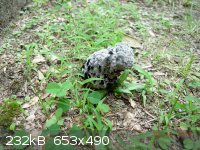
[Edited on 14-8-2013 by Morgan]
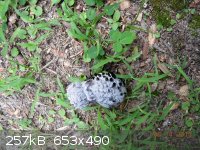
|
|
|
bfesser
Resident Wikipedian
    
Posts: 2114
Registered: 29-1-2008
Member Is Offline
Mood: No Mood
|
|
I saw these <a href="http://en.wikipedia.org/wiki/Morchella" target="_blank">morels</a> <img src="../scipics/_wiki.png" /> growing
in <a href="http://en.wikipedia.org/wiki/Interstate_Park" target="_blank">Interstate Park</a> <img src="../scipics/_wiki.png" /> (MN
side) while attending a field geology lecture with a friend. Nobody else in the group had noticed them, and when I went back to snap a photo as
evidence, they were gone. Apparently, they had all been picked by a couple of mushroom hunters who were kind enough to let me take this picture.
<table><tr><td>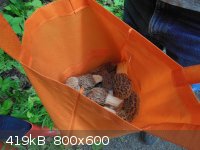 </td></tr><tr><td align="center"><em><a href="http://en.wikipedia.org/wiki/Morchella_esculenta"
target="_blank">Morchella esculenta</a></em> <img src="../scipics/_wiki.png" /><br />yellow
morel</td></tr></table> </td></tr><tr><td align="center"><em><a href="http://en.wikipedia.org/wiki/Morchella_esculenta"
target="_blank">Morchella esculenta</a></em> <img src="../scipics/_wiki.png" /><br />yellow
morel</td></tr></table>
[edit] I found more while walking around my neighborhood this afternoon (sorry for overexposure & wonky focus, all I had was my phone camera).
<table><tr><td>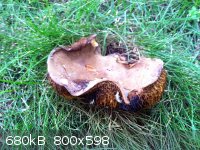 </td><td> </td><td>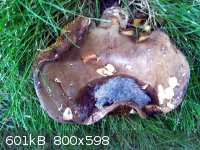 </td><td> </td><td>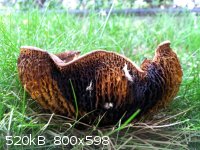 </td></tr><tr><td align="center" colspan="3"><em><a href="http://en.wikipedia.org/wiki/Boletinellus_merulioides"
target="_blank">Gyrodon merulioides</a></em> <img src="../scipics/_wiki.png" /><br />ash
bolete</td></tr></table> </td></tr><tr><td align="center" colspan="3"><em><a href="http://en.wikipedia.org/wiki/Boletinellus_merulioides"
target="_blank">Gyrodon merulioides</a></em> <img src="../scipics/_wiki.png" /><br />ash
bolete</td></tr></table>
<table><tr><td valign="bottom">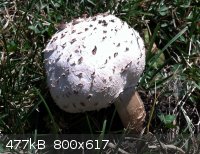 </td><td> </td><td>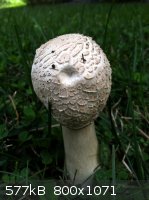 </tr><tr><td align="center" colspan="2">unidentified</td></tr></table> </tr><tr><td align="center" colspan="2">unidentified</td></tr></table>
<table><tr><td>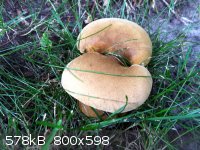 </td><td> </td><td>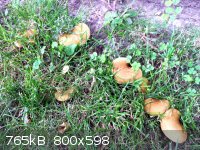 </td></tr><tr><td align="center" colspan="2">unidentified</td></tr></table> </td></tr><tr><td align="center" colspan="2">unidentified</td></tr></table>
<table><tr><td>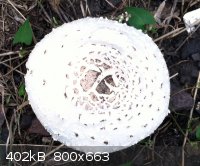 </td><td valign="bottom"> </td><td valign="bottom">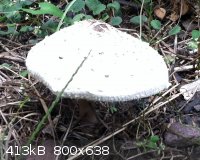 </td></tr><tr><td align="center" colspan="2">unidentified</td></tr></table> </td></tr><tr><td align="center" colspan="2">unidentified</td></tr></table>
[Edited on 15.8.13 by bfesser]
|
|
|
bfesser
Resident Wikipedian
    
Posts: 2114
Registered: 29-1-2008
Member Is Offline
Mood: No Mood
|
|
More Mushrooms
<table><tr><td>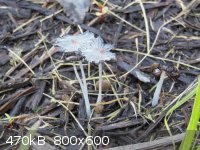 </td><td> </td><td>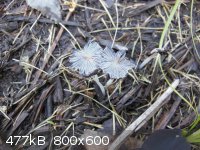 </td><td> </td><td>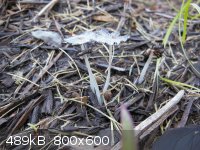 </td></tr><tr><td align="center" colspan="3">identification pending</td></tr></table> </td></tr><tr><td align="center" colspan="3">identification pending</td></tr></table>
<table><tr><td>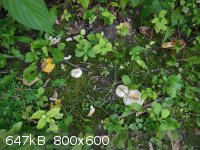 </td><td> </td><td>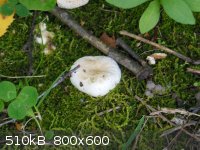 </td></tr><tr><td align="center" colspan="2">unidentified</td></tr></table> </td></tr><tr><td align="center" colspan="2">unidentified</td></tr></table>
|
|
|
Morgan
International Hazard
    
Posts: 1660
Registered: 28-12-2010
Member Is Online
Mood: No Mood
|
|
I took some photos of a blue mushroom growing under this kraken looking tree today. The inky indigo color was kind of pretty. Maybe if you were in a
culinary mindset you could plate a meal with blue spots or fancy drizzle patterns around the dish to dress it up for something different or
avant-garde.
"Although L. indigo is a well-known edible species, opinions vary on its desirability. For example, American mycologist David Arora considers it a
"superior edible",[9] while a field guide on Kansas fungi rates it as "mediocre in quality"
"The flesh is pallid to bluish in color, slowly turning greenish after being exposed to air ..."
"(7-Isopropenyl-4-methylazulen-1-yl)methyl stearate, the blue lipophilic azulene pigment from L. indigo. The part of the molecule responsible for its
color (chromophore) is highlighted in blue."
http://en.wikipedia.org/wiki/Lactarius_indigo
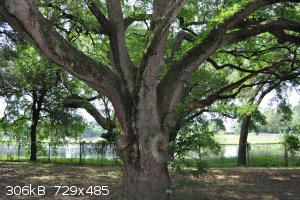 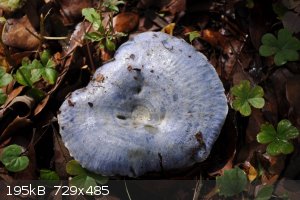 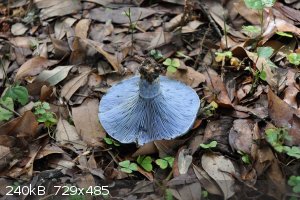 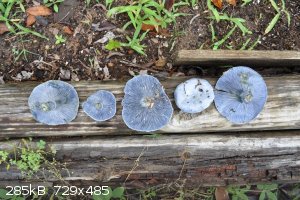 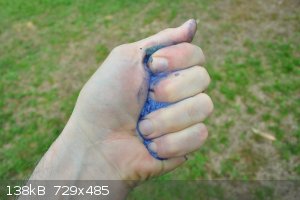 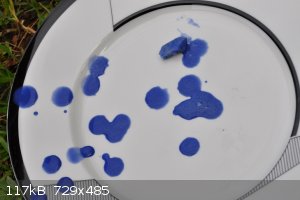
|
|
|
violet sin
International Hazard
    
Posts: 1475
Registered: 2-9-2012
Location: Daydreaming of uraninite...
Member Is Offline
Mood: Good
|
|
nice, I find those and the indigo clitocybe ( http://en.wikipedia.org/wiki/Clitocybe_nuda ) around here. about a week ago I found a solitary yellow foot chanterelle way out of season. Some
of the large "sweet tooth" hedgehog's are still going under the eucalyptus trees. also seemingly way out of season here. every year I take a hundred
or more pic's on my food gathering quests. some from this last season...
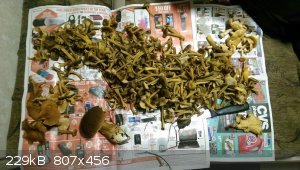 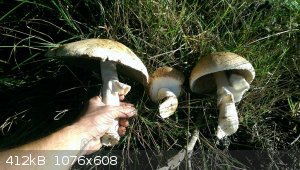 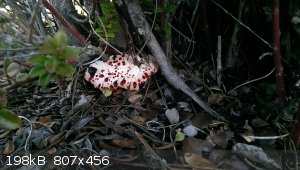
 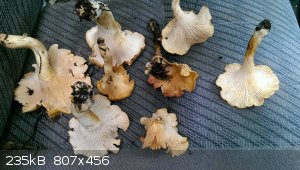 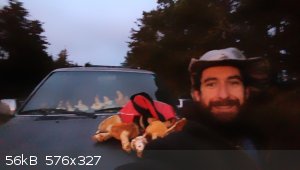
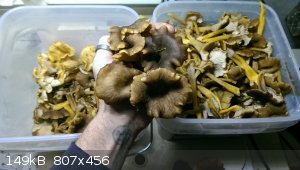
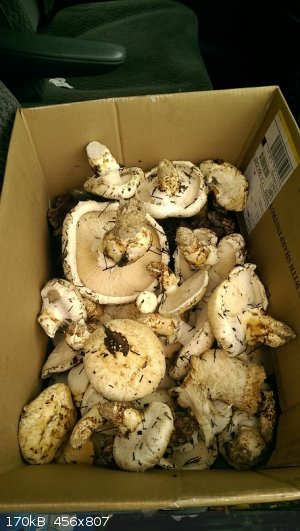
1) clock wise from top left,.. yellow foot chanterelle- Craterellus tubaeformis( big diagonal stripe), hedgehog mushroom- Hydnum repandum, golden
chanterelle -Cantharellus cibarius, king bolete- Boletus edulis, candy caps -Lactarius fragilis
2) prince mushrooms - Agaricus augustus
3) strawberries and cream- Hydnellum peckii
4) my son in his stroller with a bunch of white matsutake in the bottom- Tricholoma magnivelare
5) gold chanterelle's from a jobsite, Cantharellus cibarius
6) me with some white matsutake's picked after work- Tricholoma magnivelare
7) yellow foot chanterelle's- Craterellus tubaeformis
8) big box-o-matsutake's - Tricholoma magnivelare
[Edited on 29-4-2015 by violet sin]
|
|
|
Morgan
International Hazard
    
Posts: 1660
Registered: 28-12-2010
Member Is Online
Mood: No Mood
|
|
I don't know very much about mushrooms. One time I picked some morels on a farm in Illinois and I can't forget how good they tasted. Here's a few
tidbits on the Lactarius indigos I dug up today.
"Habitat and conservation: Grows scattered or in groups on soil in oak and pine woods. The color of this mushroom is very unusual, so when you see a
blue mushroom that literally "bleeds blue," it is almost certainly an indigo milky."
"Status: An excellent edible. Add this mushroom to scrambled eggs, and they'll turn green!"
"Ecosystem connections: This is one of many fungus species that help nourish forest trees through symbiosis. The netlike fibers of the fungus cover
the surface of a tree’s roots, increasing the surface area and the roots’ ability to absorb water and nutrients. In return, the tree shares
nutrients with the fungus."
http://mdc.mo.gov/discover-nature/field-guide/indigo-milky
Some good photos here with a nice expose'.
http://www.tyrantfarms.com/a-delicious-indigo-milk-cap-recip...
Here is a caution about a possible look-alike and another somewhat blue mushroom Clitocybe - one that you mentioned seeing. Looks like you have a
bounty with your foraging skills. There's a lot of fun facts about mushrooms to be sure. Thanks for sharing.
http://botit.botany.wisc.edu/toms_fungi/june2000.html
"There are at least eleven purple Cortinarius species, including C. violaceus, C. alboviolaceus and C. traganus. Cortinarius species should never be
eaten, primarily because they have not been fully studied for toxins. More than sixty species of Cortinarius have been found to contain orellanine, a
toxic cyclopeptide that causes serious damage to the kidneys, but only after a very long latent period; the first symptoms do not appear until 2-14
days after the mushroom has been eaten. About 15% of reported cases have been fatal. So you should be absolutely sure of what you are eating before
you try Clitocybe nuda-- always make spore prints!!!"
http://botit.botany.wisc.edu/toms_fungi/nov98.html
http://en.wikipedia.org/wiki/List_of_Cortinarius_species#/me...
http://en.wikipedia.org/wiki/List_of_Cortinarius_species#/me...
http://en.wikipedia.org/wiki/List_of_Cortinarius_species
http://en.wikipedia.org/wiki/Cortinarius
[Edited on 29-4-2015 by Morgan]
|
|
|
Morgan
International Hazard
    
Posts: 1660
Registered: 28-12-2010
Member Is Online
Mood: No Mood
|
|
I found the indigo mushroom again, this time on some bluffs near the bay. It was surrounded by oak leaves which I cleared away for this first photo.
The stem was very short so it was hard to lift without damaging the gills. With all the leaves, the mushroom didn't really stand out and might have
gone unnoticed.
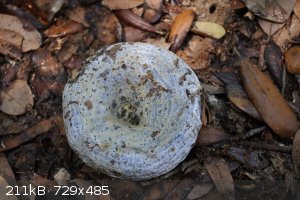 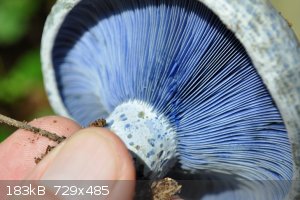 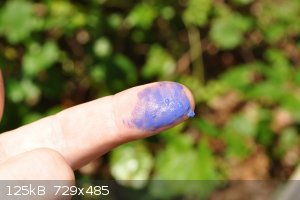  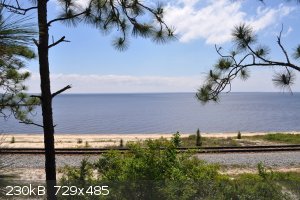 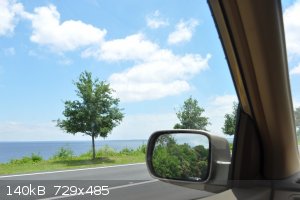
|
|
|
Loptr
International Hazard
    
Posts: 1347
Registered: 20-5-2014
Location: USA
Member Is Offline
Mood: Grateful
|
|
These are very nice pictures, guys! I never got into the mushroom hunting thing, although I have read a little bit about them.
|
|
|
Morgan
International Hazard
    
Posts: 1660
Registered: 28-12-2010
Member Is Online
Mood: No Mood
|
|
As an aside, I thought it of note that there was an ammonia leak long ago not very far from where I took these pictures. The day of mushroom hunting I
saw this train go by and thought about the incident. It's just a story I heard about. Perhaps this should be a new thread - Closely Watched Trains.
"The Thorshov story began on November 9, 1977. Dr. Jon Thorshov, a thirty-eight-year-old physician, his wife, his four-year-old daughter, and his
one-year-old son were at their home in Pensacola when a massive freight train operated by L&N derailed near their home and released anhydrous
ammonia. The family attempted to escape their home, but were overcome by the fumes. Dr. and Ms. Thorshov died, and both children sustained serious
physical injuries."
http://en.wikipedia.org/wiki/Fred_Levin
"The train was carrying a toxic chemical called anhydrous ammonia. Two tanks of the ammonia were punctured in the crash, sending lethal doses of
poison gas into the atmosphere."
"The derailment occurred 40 yards from the Thorshov’s home. In addition to Dr. Thorshov’s death, each member of the family was seriously injured.
Sadly, they had only lived in their house for one month before the accident."
http://inweekly.net/wordpress/?p=4068

|
|
|
mayko
International Hazard
    
Posts: 1218
Registered: 17-1-2013
Location: Carrboro, NC
Member Is Offline
Mood: anomalous (Euclid class)
|
|
A few weeks ago I went out in the woods with a friend who's an experienced shroomer. We found several big patches of cinnabar chanterelle; they were
very tasty!
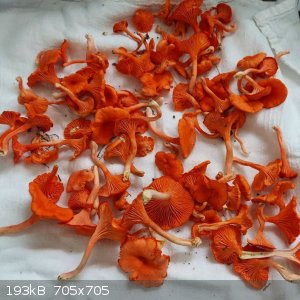 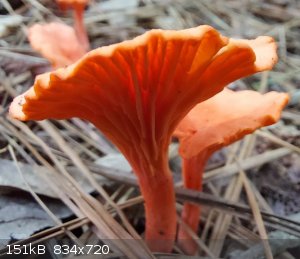
I wouldn't trust my own ID skills for most things, but chicken-of-the-woods is pretty unmistakeable. There's a huge one in the woods near my place,
which I've seen flush for the last three Augusts. This year I cut some off and sizzled it with some herbs and salt; it soaked up all the butter I
threw in the pan. Then it went on a pizza with some marinated pizza 
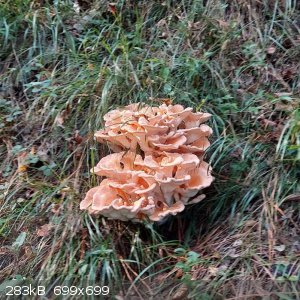 
al-khemie is not a terrorist organization
"Chemicals, chemicals... I need chemicals!" - George Hayduke
"Wubbalubba dub-dub!" - Rick Sanchez
|
|
|
Dr.Bob
International Hazard
    
Posts: 2656
Registered: 26-1-2011
Location: USA - NC
Member Is Offline
Mood: No Mood
|
|
A guy who lives down the road from me, wrote a guide to mushroom foraging, called:
How to Forage for Mushrooms without Dying: An Absolute Beginner's Guide to Identifying 29 Wild, Edible Mushrooms
by Frank Hyman | Oct 5, 2021
https://www.amazon.com/How-Forage-Mushrooms-without-Dying/dp...
One of my other neighbors says it is a great book for identifying ones to eat or not eat. Good luck.
|
|
|
| Pages:
1
2 |